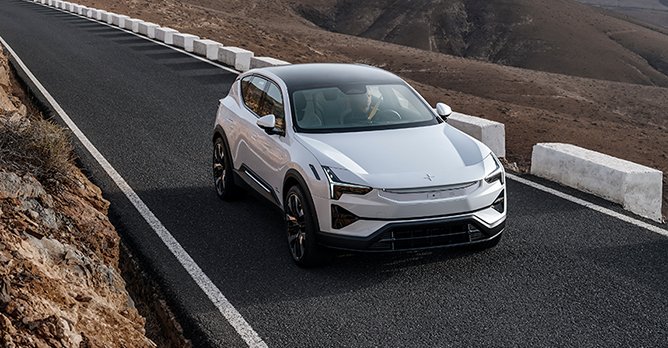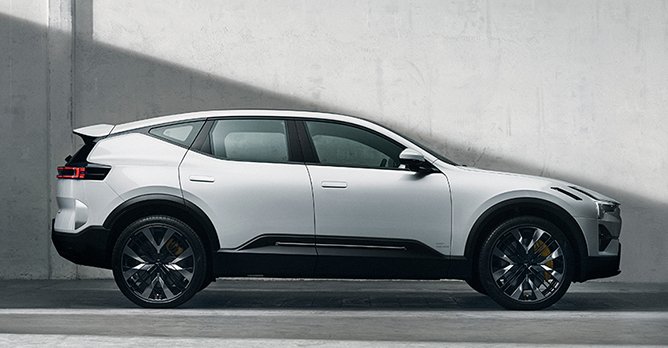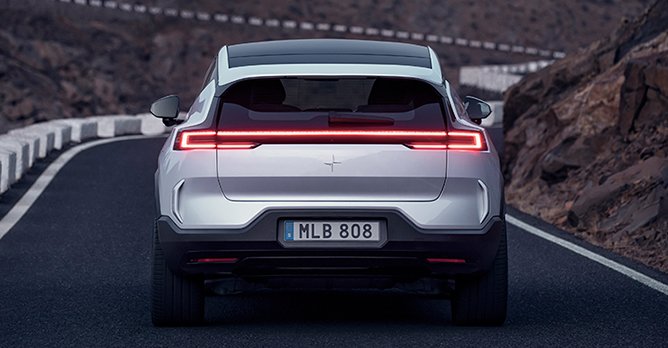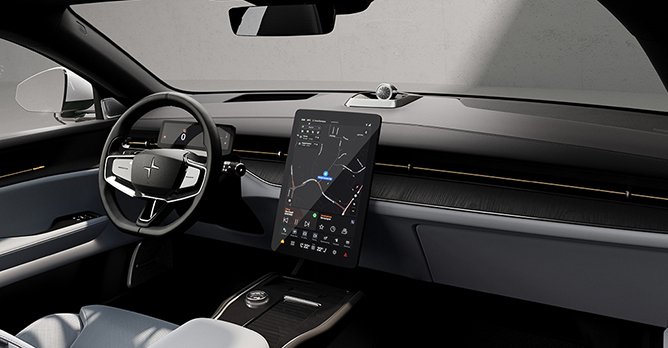The all new Polestar 3 officially unveiled
13 Oct 2022|13,909 views
Polestar, the performance electric division of Volvo, has just unveiled its Polestar 3, a fully electric SUV that will take on capable cars like the Audi e-tron S Sportback, BMW iX, Mercedes EQE SUV as well as the Tesla Model Y. The first in Singapore was the Polestar 2, a compact sedan that has its eyes on the Tesla Model 3.
The Polestar 3, despite its simple name, is more than just a simple car. The carmaker is pitching the electric SUV, with its dual-motor configuration, as a sporty and technology leader, with a Performance Pack variant that is powered by 510bhp and a mountain-moving 910Nm of torque (up from 483bhp and 840Nm on the regular Long Range Dual Motor model).

 The Polestar 3 is positioned as a high-powered electric SUV that wants to be a sporty and technology leader These figures are currently significantly higher than any of its peers in its class and would hence position the Polestar 3 to compete against high-powered electric SUVs in the market. In comparison, the new Polestar SUV is even more powerful than the Audi e-tron S Sportback.
The Polestar 3 is positioned as a high-powered electric SUV that wants to be a sporty and technology leader These figures are currently significantly higher than any of its peers in its class and would hence position the Polestar 3 to compete against high-powered electric SUVs in the market. In comparison, the new Polestar SUV is even more powerful than the Audi e-tron S Sportback.
Speaking to Beatrice Simonsson, Head of Product Team, the new SUV is based on the same SPA2 platform and uses similar batteries as the Volvo EX90 (supposedly the full electric version of the Volvo XC90), but the main differentiation between the two electric vehicles is that the Polestar 3 will embody a sleek silhouette and focus more on performance than cargo space.
She added that while Volvo's designs appeal to a broader audience especially larger families, a Polestar is marketed to be sportier and more progressive.
On first glance, the Polestar 3 looks sporty and dynamic indeed, with form meeting function. Sporty details such as a rear spoiler and a low-slung silhouette are more than just sexy design details, as they help with aerodynamics. Plus, air vents at the front of the bonnet and behind the rear wheels as well as flush door handles all help the Polestar 3 glide smoothly against the wind while on the go.
Other modern details include a full-width taillight, a pinched frontal fascia and a set of 22-inch rims on the Performance Pack variant (standard variant will have 21-inch) that give the electric SUV an overall up-to-date and alluring design.
As for the way it drives, the Polestar 3 comes with an adjustable one-pedal drive as well as an electric Torque Vectoring Dual Clutch function on the rear axle. A decoupling function is also available for the rear electric motor, allowing the car to run only on the front electric motor to save energy under different driving conditions.
Impressively, the Polestar 3 also comes with advanced chassis control that is provided by dual-chamber air suspension as standard, allowing the electric SUV to adapt between comfort and dynamic suspension characteristics. In other words, the car can adjust its active damper velocity electronically once every two milliseconds.
However, this can only be confirmed after an in-depth test drive is done.
The Polestar 3 SUV will launch as a dual-motor all-wheel drive vehicle with an 111kWh battery. Whether a single-motor version will follow remains unknown at the moment. What's known, on the other hand, is that the new electric SUV is capable of 610km of range under WLTP testing.
The Polestar 3 will be manufactured in the United States and China, and production will begin in early 2023. Singaporeans can expect the car to arrive on our shores at the end of 2023.
The Polestar 3, despite its simple name, is more than just a simple car. The carmaker is pitching the electric SUV, with its dual-motor configuration, as a sporty and technology leader, with a Performance Pack variant that is powered by 510bhp and a mountain-moving 910Nm of torque (up from 483bhp and 840Nm on the regular Long Range Dual Motor model).

Speaking to Beatrice Simonsson, Head of Product Team, the new SUV is based on the same SPA2 platform and uses similar batteries as the Volvo EX90 (supposedly the full electric version of the Volvo XC90), but the main differentiation between the two electric vehicles is that the Polestar 3 will embody a sleek silhouette and focus more on performance than cargo space.
She added that while Volvo's designs appeal to a broader audience especially larger families, a Polestar is marketed to be sportier and more progressive.
On first glance, the Polestar 3 looks sporty and dynamic indeed, with form meeting function. Sporty details such as a rear spoiler and a low-slung silhouette are more than just sexy design details, as they help with aerodynamics. Plus, air vents at the front of the bonnet and behind the rear wheels as well as flush door handles all help the Polestar 3 glide smoothly against the wind while on the go.
Other modern details include a full-width taillight, a pinched frontal fascia and a set of 22-inch rims on the Performance Pack variant (standard variant will have 21-inch) that give the electric SUV an overall up-to-date and alluring design.
As for the way it drives, the Polestar 3 comes with an adjustable one-pedal drive as well as an electric Torque Vectoring Dual Clutch function on the rear axle. A decoupling function is also available for the rear electric motor, allowing the car to run only on the front electric motor to save energy under different driving conditions.
Impressively, the Polestar 3 also comes with advanced chassis control that is provided by dual-chamber air suspension as standard, allowing the electric SUV to adapt between comfort and dynamic suspension characteristics. In other words, the car can adjust its active damper velocity electronically once every two milliseconds.
However, this can only be confirmed after an in-depth test drive is done.
The Polestar 3 SUV will launch as a dual-motor all-wheel drive vehicle with an 111kWh battery. Whether a single-motor version will follow remains unknown at the moment. What's known, on the other hand, is that the new electric SUV is capable of 610km of range under WLTP testing.
The Polestar 3 will be manufactured in the United States and China, and production will begin in early 2023. Singaporeans can expect the car to arrive on our shores at the end of 2023.
Polestar, the performance electric division of Volvo, has just unveiled its Polestar 3, a fully electric SUV that will take on capable cars like the Audi e-tron S Sportback, BMW iX, Mercedes EQE SUV as well as the Tesla Model Y. The first in Singapore was the Polestar 2, a compact sedan that has its eyes on the Tesla Model 3.
The Polestar 3, despite its simple name, is more than just a simple car. The carmaker is pitching the electric SUV, with its dual-motor configuration, as a sporty and technology leader, with a Performance Pack variant that is powered by 510bhp and a mountain-moving 910Nm of torque (up from 483bhp and 840Nm on the regular Long Range Dual Motor model).

 The Polestar 3 is positioned as a high-powered electric SUV that wants to be a sporty and technology leader These figures are currently significantly higher than any of its peers in its class and would hence position the Polestar 3 to compete against high-powered electric SUVs in the market. In comparison, the new Polestar SUV is even more powerful than the Audi e-tron S Sportback.
The Polestar 3 is positioned as a high-powered electric SUV that wants to be a sporty and technology leader These figures are currently significantly higher than any of its peers in its class and would hence position the Polestar 3 to compete against high-powered electric SUVs in the market. In comparison, the new Polestar SUV is even more powerful than the Audi e-tron S Sportback.
Speaking to Beatrice Simonsson, Head of Product Team, the new SUV is based on the same SPA2 platform and uses similar batteries as the Volvo EX90 (supposedly the full electric version of the Volvo XC90), but the main differentiation between the two electric vehicles is that the Polestar 3 will embody a sleek silhouette and focus more on performance than cargo space.
She added that while Volvo's designs appeal to a broader audience especially larger families, a Polestar is marketed to be sportier and more progressive.
On first glance, the Polestar 3 looks sporty and dynamic indeed, with form meeting function. Sporty details such as a rear spoiler and a low-slung silhouette are more than just sexy design details, as they help with aerodynamics. Plus, air vents at the front of the bonnet and behind the rear wheels as well as flush door handles all help the Polestar 3 glide smoothly against the wind while on the go.
Other modern details include a full-width taillight, a pinched frontal fascia and a set of 22-inch rims on the Performance Pack variant (standard variant will have 21-inch) that give the electric SUV an overall up-to-date and alluring design.
As for the way it drives, the Polestar 3 comes with an adjustable one-pedal drive as well as an electric Torque Vectoring Dual Clutch function on the rear axle. A decoupling function is also available for the rear electric motor, allowing the car to run only on the front electric motor to save energy under different driving conditions.
Impressively, the Polestar 3 also comes with advanced chassis control that is provided by dual-chamber air suspension as standard, allowing the electric SUV to adapt between comfort and dynamic suspension characteristics. In other words, the car can adjust its active damper velocity electronically once every two milliseconds.
However, this can only be confirmed after an in-depth test drive is done.
The Polestar 3 SUV will launch as a dual-motor all-wheel drive vehicle with an 111kWh battery. Whether a single-motor version will follow remains unknown at the moment. What's known, on the other hand, is that the new electric SUV is capable of 610km of range under WLTP testing.
The Polestar 3 will be manufactured in the United States and China, and production will begin in early 2023. Singaporeans can expect the car to arrive on our shores at the end of 2023.
The Polestar 3, despite its simple name, is more than just a simple car. The carmaker is pitching the electric SUV, with its dual-motor configuration, as a sporty and technology leader, with a Performance Pack variant that is powered by 510bhp and a mountain-moving 910Nm of torque (up from 483bhp and 840Nm on the regular Long Range Dual Motor model).

Speaking to Beatrice Simonsson, Head of Product Team, the new SUV is based on the same SPA2 platform and uses similar batteries as the Volvo EX90 (supposedly the full electric version of the Volvo XC90), but the main differentiation between the two electric vehicles is that the Polestar 3 will embody a sleek silhouette and focus more on performance than cargo space.
She added that while Volvo's designs appeal to a broader audience especially larger families, a Polestar is marketed to be sportier and more progressive.
On first glance, the Polestar 3 looks sporty and dynamic indeed, with form meeting function. Sporty details such as a rear spoiler and a low-slung silhouette are more than just sexy design details, as they help with aerodynamics. Plus, air vents at the front of the bonnet and behind the rear wheels as well as flush door handles all help the Polestar 3 glide smoothly against the wind while on the go.
Other modern details include a full-width taillight, a pinched frontal fascia and a set of 22-inch rims on the Performance Pack variant (standard variant will have 21-inch) that give the electric SUV an overall up-to-date and alluring design.
As for the way it drives, the Polestar 3 comes with an adjustable one-pedal drive as well as an electric Torque Vectoring Dual Clutch function on the rear axle. A decoupling function is also available for the rear electric motor, allowing the car to run only on the front electric motor to save energy under different driving conditions.
Impressively, the Polestar 3 also comes with advanced chassis control that is provided by dual-chamber air suspension as standard, allowing the electric SUV to adapt between comfort and dynamic suspension characteristics. In other words, the car can adjust its active damper velocity electronically once every two milliseconds.
However, this can only be confirmed after an in-depth test drive is done.
The Polestar 3 SUV will launch as a dual-motor all-wheel drive vehicle with an 111kWh battery. Whether a single-motor version will follow remains unknown at the moment. What's known, on the other hand, is that the new electric SUV is capable of 610km of range under WLTP testing.
The Polestar 3 will be manufactured in the United States and China, and production will begin in early 2023. Singaporeans can expect the car to arrive on our shores at the end of 2023.
Latest COE Prices
August 2025 | 1st BIDDING
NEXT TENDER: 20 Aug 2025
CAT A$102,009
CAT B$123,498
CAT C$70,001
CAT E$122,334
View Full Results Thank You For Your Subscription.




































